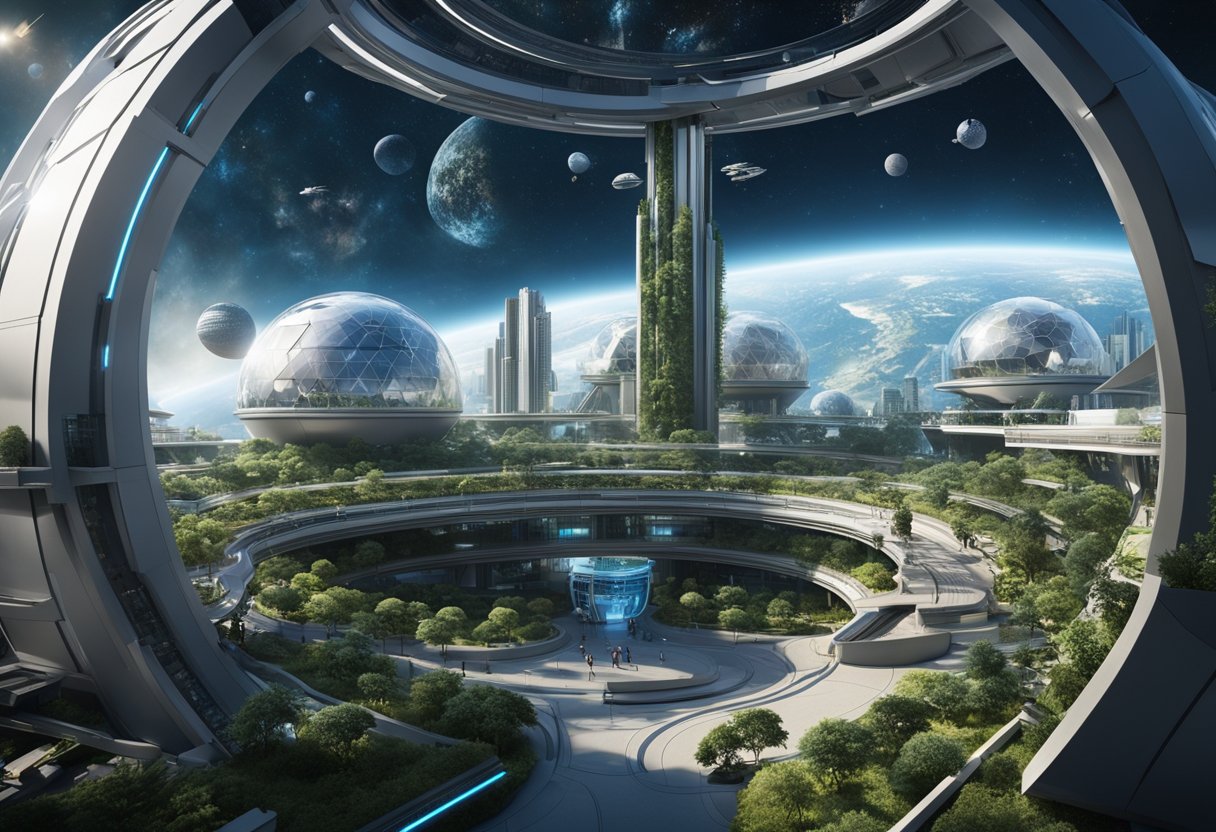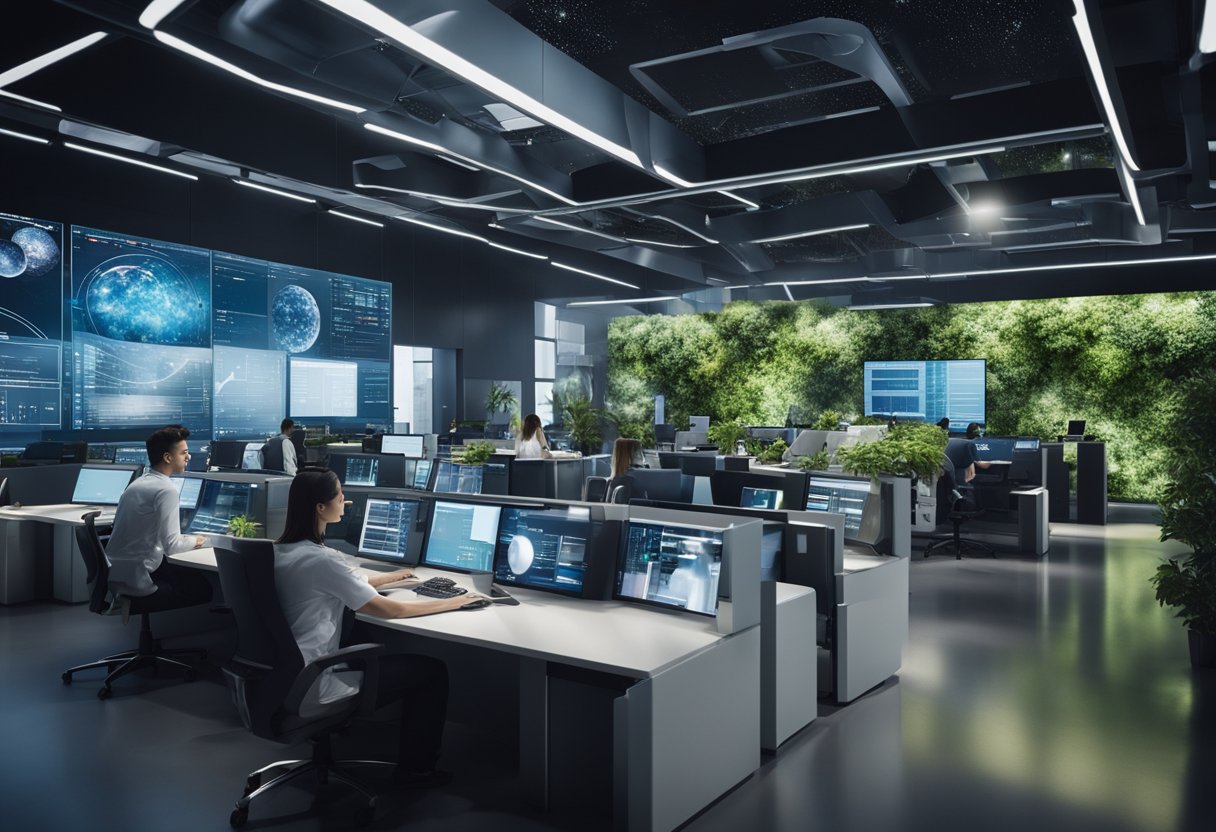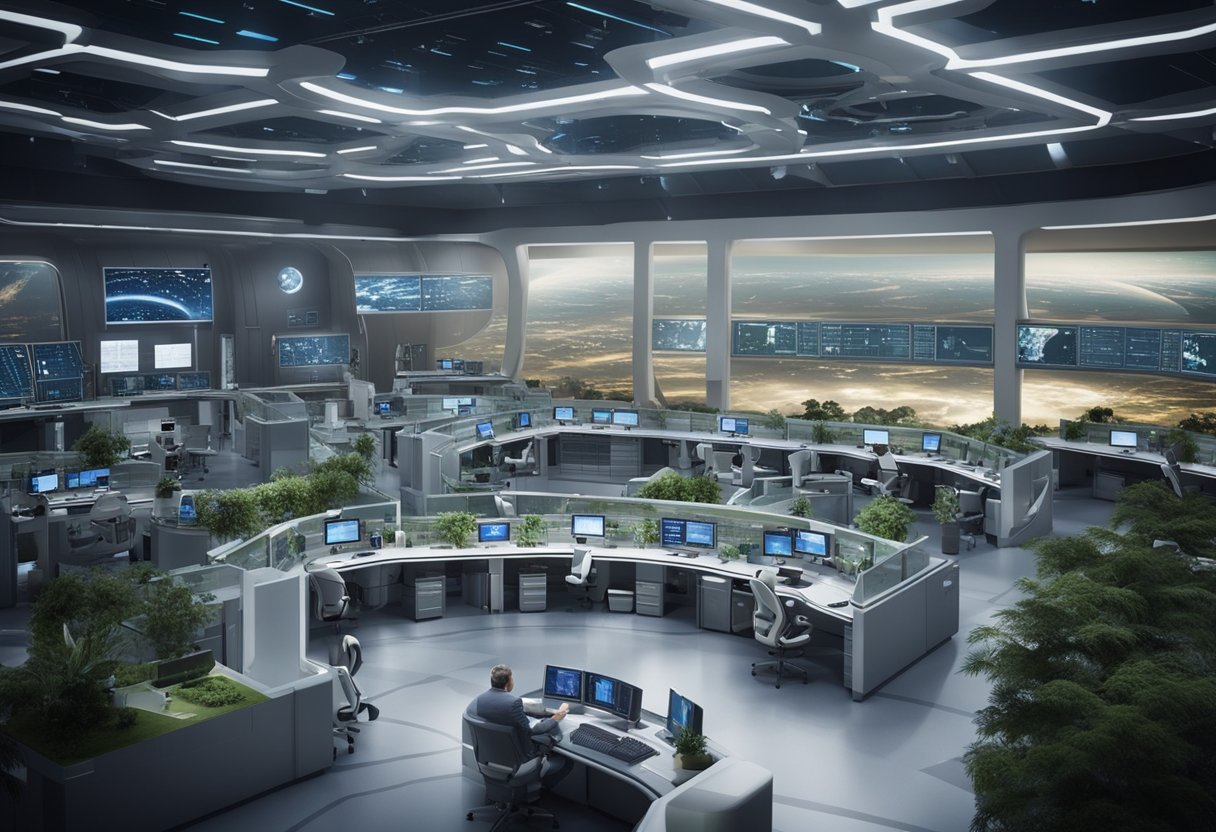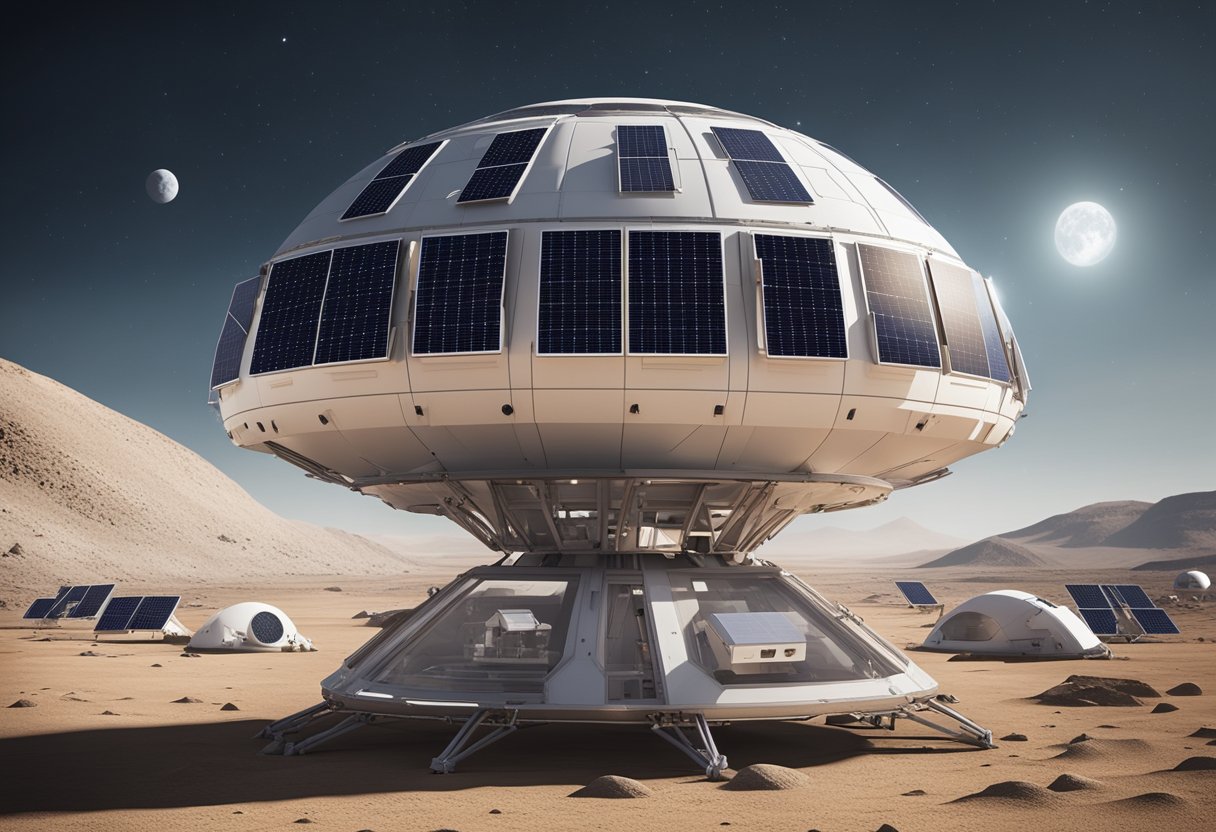
Space Habitats Population – As we contemplate the relentless growth of the global population and the limitations of urban expansion on Earth, the future of human dwellings naturally ventures beyond terra firma. The projection of population growth within future space habitats considers not only the necessity of accommodating a burgeoning populace but also the sustainability and viability of living off-planet. This is driven by environmental considerations, as well as the need to establish new socioeconomic pathways that can flourish in extraterrestrial environments.

Turning our gaze towards the cosmos, space exploration has evolved from singular, heroic missions to a comprehensive vision of permanent settlements. The development of these habitats responds to Earth’s limitations, promising a blend of high technology and human adaptability. We see interest not just from governmental agencies like NASA, but from private sector entities poised to frame the economics of space colonisation. Such advancements suggest a future where humanity’s survival and growth could very well hinge on the successful establishment of extraterrestrial communities.
These developments underscore the efforts to build a framework for inhabiting space—a topic we’re increasingly conscious of through resources like SpaceVoyageVentures.com, which showcases the emerging realm of space tourism and habitation that could soon be within our reach.
Projected population growth in space habitats hinges on understanding complex demographic factors and employing sophisticated quantitative models. The successful prediction of such growth patterns is vital for ensuring the sustainability and socioeconomic viability of these communities beyond Earth.
The variables influencing population growth within space habitats are multifaceted. Key factors include birth rates, which are affected by the living conditions and resources available in the habitat, and migration rates, which are contingent on Earth-to-space travel access and the allure of space ventures charted by budding enterprises like SpaceVoyageVentures.com. Socioeconomic elements, such as job availability and habitat affordability, also play critical roles in determining who may decide to venture into these habitats and make them their home.
To create accurate population projections for space habitats, researchers must develop models that account for the unique conditions of living off-planet. These include the limited size of habitats, such as the Stanford torus, a habitat design that aims to support artificial gravity and could potentially accommodate thousands of inhabitants. Models also need to integrate how technological advancements and socioeconomic strata may evolve and influence population dynamics.
Our quantitative projections incorporate existing research and aim to synthesise it with realistic scenarios for future development. This analysis helps us anticipate shifts in population size and demographic composition over time, with close attention to the carrying capacity of space environments and the potential ripple effects on Earth’s economies and societies.

In the pursuit of establishing space habitats, we must prioritise environmental sustainability alongside technical viability, ensuring that future generations may thrive extraterrestrially.
When assessing potential locations for space habitats, we examine environmental variables critical for human survival. This includes temperature, radiation levels, and the availability of vital resources, such as water. Habitability is contingent upon our ability to create a balance between human needs and the harsh conditions of space.
Our life support systems are engineered to provide a stable supply of air, water, and food. These systems are designed to be both redundant and efficient, utilising advanced AI to monitor and adjust environmental conditions, thereby ensuring the safety and comfort of all inhabitants. The use of closed-loop systems, which recycle waste into usable resources, is integral for long-term sustainability.
The creation of artificial ecosystems is instrumental in establishing self-sustaining habitats that can support human life indefinitely. These ecosystems mimic Earth’s natural cycles and provide a psychological benefit to inhabitants. Our integration of plants and microorganisms not only recycles carbon dioxide but also contributes to the mental well-being of our population, creating a green respite from the sterility of space.
For insight into the future development of space habitats and the potential for space tourism, visit SpaceVoyageVentures.com.
In addressing Earth’s burgeoning urban populations and the resulting scarcity of urban land, we turn our gaze to the cosmos. Space habitats present a bold solution to these terrestrial challenges.
Urban land is finite. As cities swell, we’re reaching physical and environmental thresholds. By the mid-21st century, projections suggest that up to 78% of us could be urban dwellers, according to a study in Nature. This intensifies the strain on resources and amplifies the impact of climate change. Our footprints expand, but the square footage of Earth’s urban-able land does not.
Escaping these confines, space habitats offer a conceptual expanse. Organisations like SpaceVoyageVentures.com present an embryonic vision of the broader role these off-world colonies could serve, from leisure to long-term living.
Our socio-economic dynamics are the engines of this cosmic migration. As economic and population pressures on Earth’s cities spike, our collective efforts shift toward the sustainability and viability of habitats in space. The implications are vast. We’re challenging our technological capabilities, but we’re also opening doors to unparalleled socio-economic opportunities where every stratum of society may one day reap benefits.
By venturing outwards, we foresee our urban landscape transitioning from purely terrestrial to interstellar. Space habitats, nestled among the stars, may become essential extensions of our rapidly urbanising society.

In addressing the interplay between future space habitats and global progress, we must consider the impact of international policies and socioeconomic trajectories. These frameworks are integral to shaping the sustainable development of off-Earth communities.
The United Nations (UN) plays an instrumental role in coordinating international efforts towards space habitat governance. With space exploration expanding, UN policies focus on peaceful collaboration and ensure that space activities align with the broader Sustainable Development Goals (SDGs). We recognise a growing need for policies that support the sustainability of space environments while promoting socio-economic development both on Earth and in extraterrestrial settlements.
Socioeconomic pathways and future scenarios provide insights into how societal choices will influence long-term sustainability in space habitats. The Shared Socioeconomic Pathways (SSPs), for example, are models that project how global trends in economics, urbanisation, and population growth might unfold in the coming decades. These narratives guide us in envisaging the potential socioeconomic contexts within which space habitats could develop. Spaces such as SpaceVoyageVentures.com document these evolving scenarios and their implications for both current and prospective space tourism ventures. As we navigate through these pathways, integrating economic, social, and environmental dimensions remains a central tenet of our strategies for sustainable space expansions.
As we envision the future of humanity beyond Earth, the technological leap in space habitat design plays a pivotal role. Our focus here is on the critical systems that sustain life and the robust structures that define space habitability.
In our pursuit of space colonisation, the development of sophisticated life support systems has been imperative. We have established methods to recycle air and water with high efficiency, ensuring a continuous supply of breathable air and potable water in the vacuum of space. For instance, advanced air filtration technologies have been a game-changer, employing chemical scrubbers and closed-loop systems to remove carbon dioxide and replenish oxygen.
Research into regenerative life support has vastly improved, with the integration of bioregenerative components like algae bio-reactors and plant growth chambers that contribute to air purification and food production, fostering a self-sufficient habitat. Space Habitats: Navigating the Future Beyond Earth details these systems, highlighting the crucial role they play in sustained human presence in space.
The viability of long-term habitats in space has necessitated the creation of durable and adaptive structures. Modern materials science has ushered in the use of lightweight, high-strength composites and radiation-resistant alloys—essential in shielding inhabitants from the harsh space environment.
Our technology has matured to include the ability to expand and contract habitats based on population dynamics and spatial requirements. This adaptability is crucial for maintaining efficient use of space and resources. Simultaneously, research into habitat designs offers promising insights into creating structures capable of mimicking Earth’s gravity to counteract the health effects of microgravity as shown in Review of space habitat designs for long term space explorations.
Moreover, the considerations of space architecture have evolved to understand that habitats are more than mere shelters. They are complex ecosystems that must support human psychology and social needs. We explore these aspects in greater detail through virtual simulations and test-bed environments offered by pioneering companies like SpaceVoyageVentures.com, which gives us a window into the thriving space tourism industry and the habitats that will accommodate these travellers.

As we move towards establishing human habitats beyond Earth, the economic implications of space colonisation will likely be transformative, affecting resource utilisation, trade, investment, and the broader space economy.
We understand that space resources are pivotal to the sustainability and economic viability of long-term space exploration. Utilising in-situ materials, such as water ice from the Moon or asteroids, to support life and fuel spacecraft, could dramatically reduce the costs of future missions. A crucial part of this economic landscape is the trade of these resources. Establishing a robust trade system between Earth and space habitats will provide a key economic backbone for space colonisation. Moreover, the potential to harness rare materials not readily available or abundant on Earth could stimulate new markets and further integrate space resources into our global economy.
Investment and market development in space will be foundational to the success of colonisation efforts. We see investments in space infrastructure, such as the construction of habitats and the development of life support systems, as critical. The emergence of companies focused on space tourism, like SpaceVoyageVentures.com, suggests an increasing public interest and commercial investment in space. By developing a market for space travel and habitation, we’re cultivating an economic ecosystem that could possibly support not just scientific endeavours but also commercial activities in space. This emerging space economy will require nurturing through supportive policies, public-private partnerships, and continued innovation to flourish and contribute to the economic growth of space colonisation.

As we venture into the era of space habitats, understanding the implications for our health and the socioeconomic structures that will emerge is crucial. These habitats will not only have to ensure the physical and mental well-being of their residents but also manage the socioeconomic disparities that may arise.
Physical Health: We are aware that life in a space habitat presents unique challenges to our physical health. The lack of gravity can lead to muscle atrophy and bone density loss. To combat these issues, habitats are designed with artificial gravity sections and equipped with state-of-the-art gymnasiums to promote regular exercise.
Mental Health: The confined spaces and isolation pose risks to mental health, necessitating designs that include social areas and connectivity with Earth for psychological support. Programs are also in place for continuous mental health monitoring and intervention.
Economic Equality: It’s our responsibility to ensure that socioeconomic disparities are addressed in space habitats. Various roles within these communities will be essential, and fair compensation and access to habitat resources must be a given. The potential for inequality in wealth and resource allocation is a concern, and systems to manage these disparities are being developed.
Access to Healthcare: Healthcare, a fundamental need, must be accessible to all residents, irrespective of their socioeconomic status. This includes not just emergency medical care but also ongoing support for the unique health challenges faced in space. Such a commitment to health equity is pivotal to the sustainability of these communities.
In crafting future space habitats, we’re laying the groundwork for societies that uphold these values, where every individual’s well-being is a priority and socioeconomic health is part of the foundational planning. Our work at SpaceVoyageVentures.com reflects our dedication to documenting the evolution of space tourism and habitats, ensuring that we share insights into the health and socioeconomic factors that will shape life beyond Earth.

As we venture into the era of space exploration and habitation, robust governance and regulatory frameworks are essential to address policy and legal considerations, and to ensure international cooperation and manage potential conflicts.
The Outer Space Treaty, a cornerstone of space law, lays the groundwork for nations in the exploration and use of outer space. In contemplating future space habitats, we foresee a complex interplay of national policies and international regulations to maintain order and safety in these new communities. Challenges such as resource allocation and habitat jurisdiction must adhere to legal frameworks to ensure peaceful and equitable use of outer space.
International collaboration will be the linchpin for successful and sustainable space habitats. Through entities such as the UN Committee on the Peaceful Uses of Outer Space (COPUOS), we facilitate cooperation on issues like resource sharing and scientific research in space habitations.
By implementing these strategies, we lay the foundation for a preserved and collaborative future in space, as envisioned by platforms like SpaceVoyageVentures.com, which showcases the scope of human ambition in the cosmos.

Understanding Earth’s complex ecosystems and the capabilities of remote sensing technologies shapes our approach to developing sustainable living environments beyond our planet.
We’ve learned that terrestrial biodiversity offers invaluable lessons for creating resilient space habitats. By studying diverse ecological systems, we establish principles for balancing oxygen production and CO2 absorption within closed-loop life support systems. Research on Earth’s biospheres guides our design of self-sustaining habitats capable of supporting life during extended space missions, like those planned by NASA for deep space exploration.
Remote sensing and Earth observation are pivotal for our understanding of environmental dynamics. The technology informs our habitat construction by monitoring climate patterns and resource distribution on Earth. These tools aid in the selection of suitable lunar or Martian terrain, akin to landing site assessments detailed on platforms such as SpaceVoyageVentures.com. By mastering Earth-based remote sensing, we ensure our space habitats can endure extraterrestrial climates and utilise local resources effectively.

We must tailor our space habitat designs to account for the unique environments of the Moon and Mars. These designs focus on sustainable living and protection against the harsh conditions of space.
For the Moon, our strategies include utilising the regolith for shielding and constructing habitats that can withstand extreme temperature variations. The absence of atmosphere calls for designs that can protect against solar and cosmic radiation as well as micrometeorite impacts.
Habitats must be capable of accommodating periods of darkness lasting up to two weeks, necessitating energy storage solutions or nuclear power alternatives. Our surface mobility must be flexible to facilitate exploration and resource utilisation.
Mars presents a different set of challenges – a thin atmosphere, lower gravity, and the potential for use of local resources. Adaptability and self-sufficiency are critical in our habitat designs for Mars, keeping in mind the planet’s more extreme seasons and dust storms.
Habitats must be robust enough to protect against dust storms and enable long-term human survival. Our approach integrates advanced materials and autonomous building technologies to create safe, expandable living spaces for Martian settlers.

In our examination of the expanding field of off-Earth living, we touch upon the dynamic shifts in population, the innovations in habitat design, the forerunners in technology development, sustainability challenges, as well as the integration of colonisation concepts in current space missions and essential technological breakthroughs.
Populations within orbital space settlements are expected to fluctuate based on factors such as birth rates, which could differ from Earth due to unique space environments, and immigration policies, which will likely be stringent due to the complexities of space travel.
Architects are considering a variety of designs that cater to the unique challenges of space, such as radiation protection and microgravity. Modular structures and the utilisation of in-situ resources are key concepts pivotal for future space habitats.
Notable organisations like NASA, ESA, and private companies including SpaceX and Blue Origin are at the forefront of developing space habitat technology. They’re working on projects to ensure the psychological and physical wellbeing of future space residents.
The sustainability of space populations will hinge on efficient resource use, such as near-complete water recycling and robust food production systems, which are critical for supporting life in deep space habitats. These systems need to be nearly closed-loop to ensure long-term habitability.
Current plans for space exploration by leading agencies are incorporating human colonisation by focusing on sustainable life support systems and technologies that enable the construction of habitats on other celestial bodies. They’re setting the groundwork for the eventual permanent settlement of humans in space.
For establishing permanent human populations off Earth, advancements in life support, construction materials that withstand harsh space conditions, and propulsion technology are essential. Long-term survival will also depend on the development of economic and social structures that support off-Earth communities.